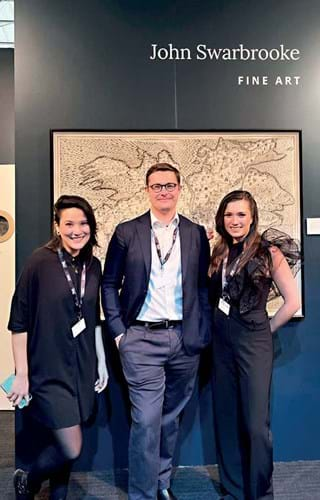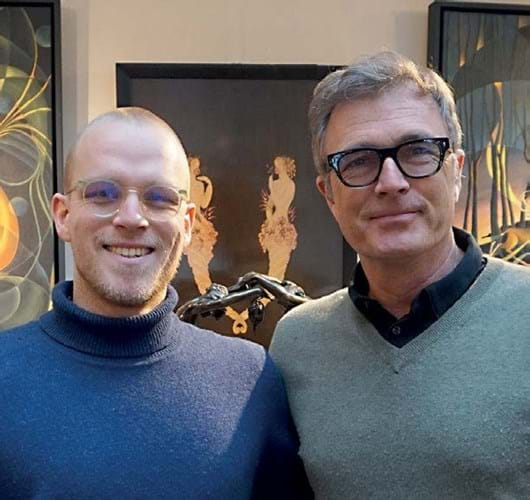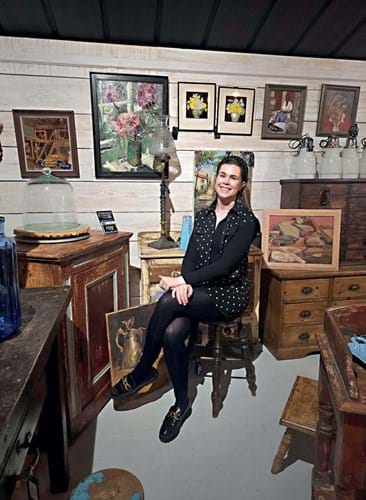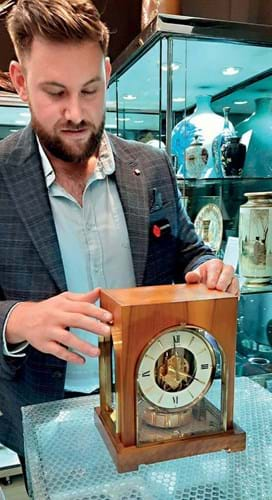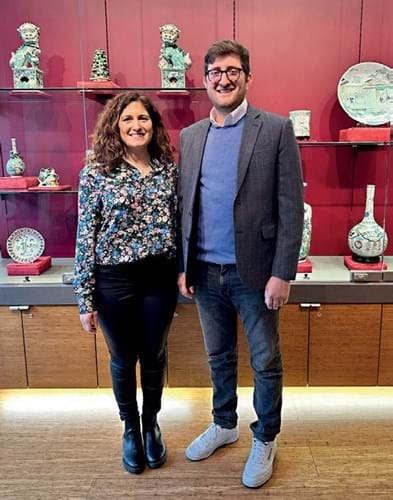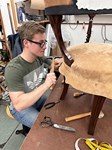Fears that as antiques dealers retire there are not enough fresh faces to replace them may be exaggerated.
Many of the under-40 set are grassroots dealers who have been coming up through markets, fairs and online trading, though younger dealers with family connections are still a significant part of the ‘next generation’.
The British Art Market in 2023 report for the British Art Market Federation (BAMF) by Art Economics found that the number of antiques dealerships and art galleries around the UK grew by more than 31% in the past decade.
The increase in social media use and growth in online platforms has also changed the way the art and antiques sector operates. For many young dealers, this has eased their transition into the trade.
Wake up to profit
Among these traders is Callum Jackson (29) of Jackson Antique who started selling and buying collectables on eBay before expanding into more high-end areas of antiques.
He now specialises in Japanese works as well as 19th century European artworks. He says one of the best things about selling on eBay is being able to make money quickly.
“If you wake up in the morning and you’ve sold something overnight, there is no better feeling than that,” Jackson tells ATG.
Managing director of IACF Antiques Fairs, Will Thomas, says: “We have seen an increase in young dealers since Covid which is encouraging as the industry lost some familiar faces to the pandemic and early retirement over that period. Speaking with a few of the new dealers the theme is similar - they wanted a business that can work around them and not a 9-5.”
Hannah Cox (34), who specialises in 18th-20th century English antiques, agrees that one of the benefits of starting out now is that there are “so many more alternative tools at our disposal for reaching out to customers - social media, eCommerce, Google adverts… It’s the younger generation who are really going to be the ones to get a grip on these new tools and work out how they can be combined with the more traditional selling methods to drive the industry forward.”
Matthew Holder (32), who specialises in Kunstkammer collections, says that he does not rely “on one way of conducting business, the more avenues you have the greater the chance of success” and adds that many of his international clientele would only have been able to find him online.
However, once these dealers build up their businesses many are setting up shop and standing at fairs alongside their more established colleagues.
John Swarbooke (32), who specialises in 20th century art with a Modern British focus, has “learned a great deal from those who are more experienced in the trade - so many dealers enjoy imparting their knowledge”.
Archie Parker (36) from the Parker Gallery, specialising in predominantly 17th-19th century paintings, also enjoys getting to pick the brains of other dealers. He says: “Overall, the social side of the trade at fairs is great fun. I regularly travel to fairs with dealers with far more experience. It can be very helpful for advice.”
Swarbrooke comes from a family with no links to the trade but does say that he has “passed the collecting bug onto [his] family now”.
Holder also says that he does not “think there’s a single antique among my family” but was encouraged to work hard and have ambitious goals from an early age.
For those who do not come from families with a history in the trade, making connections is often harder.
Jackson says: “A lot of this business is very dubious of younger trade and most of them don’t take the time to get to know you. Not the majority, just a lot of them and it’s difficult to build relationships when you’re younger in this business as a lot of it relies on experience.”
Holder says that “there can be some negativity spurred by jealousy” standing among other dealers at fairs, but “you have to have thick skin and just do your best, learn not to worry about what’s going on next door.”
Swarbrooke adds: “It takes a long time to make lasting connections and build trust with colleagues and collectors alike. With over a decade in the art world, I have established some wonderful working relationships, but it is not an overnight story.”
Equal status
Even those that have a family connection in the trade still have something to prove.
Jacob Markies (28) from Art Deco specialist Jeroen Markies comes from a long line of dealers.
His grandmother owed antiques shop Aspedistra Antiques in Forest Row, East Sussex in the 1980s. His father Jeroen joined the business, specialising in the early 2000s in Art Deco. and then Jacob followed in his father’s footsteps.
Jacob says now he is no longer in his teens or early 20s, the trade around him are finally treating him “like a colleague and equal as opposed to a colleague’s son”.
Archie Parker also followed in his father’s footsteps. Buffie Parker spent around 40 years dealing and then auctioneering, currently running his own firm Parker Fine Art Auctions in Farnham. Archie says: “We’ve never worked together and I’m not sure we could, but it’s great to gossip and argue over opinions and attributions.”
Louise Phillips, chairman of the British Antique Dealers’ Association (BADA), is “encouraged that BADA includes many members who are of the ‘younger generation’”.
She says that the association no longer just comprises the ‘old school’ but also “exciting young dealers handling and selling both traditional and contemporary works of art and antiques”. Parker and Samuel Marchant (30) are both younger dealers that sit on the BADA council.
The dealers that ATG spoke to are optimistic about the future of the trade and the growing numbers of younger dealers coming on the scene.
All of them noted the importance of being able to adapt to changes in the trade
Markies says that he thinks there is a future for up and comers but “it will be very different to what we have had in the past and even what we have now. Adapting to new technologies, trends and buying habits will define us.”
Hannah Cox (aged 34) from Jennings & Cox
What drew you to antiques?
It is just something that I have always been around. My dad was originally a gilder, and my parents had a shop in our local town when I was very young. However, it wasn’t until I bought my first house six years ago that I really started to take an interest in antiques and interiors. Don’t get me wrong, the house is still a nightmare on the interior design front, but it’s getting there!
I just love quality and craftmanship of antique and vintage pieces - whether it’s an 18th century mule chest, a Victorian pine table or a Mid-century coffee table, all of them are just superior to their modern day counterparts. Also, the ‘make do and mend’ attitude of previous generations means that a lot of these pieces have also been repaired lovingly time and time again - character like that just can’t be found anywhere else.
What’s it like exhibiting at fairs alongside people who have been in the trade much longer?
At first it can be daunting as it feels like everyone has way more confidence than you do, but, as a whole we are a very friendly industry that works very hard so I have found that a lot of traders are more than willing to help you - whether that’s with unloading and loading the van or giving you advice.
Is this your only job?
It’s been my only job now for three years. I was previously in financial services.
What advice would you give to someone trying to start out?
Be honest about the extent of your knowledge - you can’t blag a blagger and you will get caught out if you pretend to know something when you don’t! I’m forever asking other dealers questions - I am still learning and there’s no shame in that.
I’d also say don’t believe everything you watch on the TV. Those daytime TV bidding shows (you know the ones I’m talking about) are just ridiculous and largely misrepresent the industry and what we dealers do as a whole.
Callum (aged 29) from Jackson Antique
What drew you to antiques?
The history and craftsmanship definitely - for me because I come from an engineering background, that really interests me, how things are made. Incredible what they made 2000 years ago that we can’t make today. I was doing this for a good few years on the side of being a gas engineer - I used to take days off to go to the fairs and once you progress enough you get into bigger and better things.
Do you come from a family that works in the industry?
Not at all - not even remotely. We’re all farming background, nothing to do with it. My parents don’t buy antiques and I would never have even gone to a shop with them. I started selling in Star Wars figures and games consoles on eBay - I invested a lot of time in it at school.
Do you see a future for young people like yourself in the trade?
Yes, 100%. No matter what happens in the world we still have collectors and new collectors and people that want to buy and invest.
What advice would you give to someone trying to start out?
Never give up if it’s a passion and you love what you’re doing. If you love it don’t give up, no matter what anyone tells you. Find the area you want to work in. Cash flow is key but just don’t give up because you have to learn from your mistakes.
Natalie (35) and Samuel (30) from Marchant Asian Art
What drew you to antiques?
Our great grandfather started the business in 1925 and we are the fourth generation. We both appreciate the history, stories and craftmanship of the works of art we’ve been around our entire lives.
We are very lucky to have great teachers in our father and grandfather who we’ve grown up learning from. Our uncle is a film poster dealer and we also have wider family in the art business.
Has it been easy to make trade connections as a young person?
Fortunately, we’ve had a network of people built up through our family’s history and reputation in the business. As well as being able to make connections with existing clients, we’ve been able to make new ones through travelling, visiting people, and of course through social media.
How did you find exhibiting at fairs and standing alongside people that have been in the trade much longer?
We haven’t exhibited at fairs since 2016. However, we both used to work on the Marchant stand and enjoyed engaging with other dealers and meeting clients, so we were very confident in our ability to stand beside other experienced dealers from a relatively young age!
Do you see a future for young people in the trade?
Absolutely, there are always opportunities for young people who are interested in art and antiques. Especially with education being more accessible due to online learning and social media.
What advice would you give to someone trying to start out?
The most important thing is familiarising yourself with pieces in museums and visiting reputable galleries and auction houses, where they can handle genuine pieces with provenance, and speak to people who have experience and knowledge in the field. On the other hand, we would advise people not to learn from online auctions or online marketplaces, where it can be a minefield for young dealers starting out.


